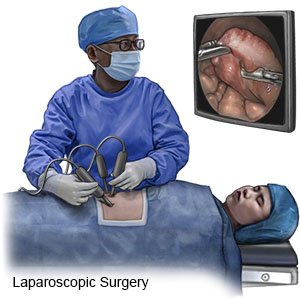Laparoscopic Oophorectomy
Medically reviewed by Drugs.com. Last updated on Aug 4, 2025.
What do I need to know about a laparoscopic oophorectomy?
A laparoscopic oophorectomy is surgery to remove one or both of your ovaries. Your surgeon will use a laparoscope (a thin tube with a light and tiny video camera on the end) and small tools to remove your ovaries. He or she may use a robot (machine) that has mechanical arms to operate the tools. This is called a robotic-assisted laparoscopic oophorectomy.
 |
How do I prepare for a laparoscopic oophorectomy?
Your surgeon will talk to you about how to prepare for surgery. He or she may tell you not to eat or drink anything after midnight on the day of your surgery. He or she will tell you what medicines to take or not take on the day of your surgery. You may need to stop taking blood thinners, aspirin, or NSAIDs several days before surgery. You may need blood tests, an x-ray, CT scan, or ultrasound before surgery. Arrange for someone to drive you home when you are discharged.
Related medications
What will happen during a laparoscopic oophorectomy?
- You will be given general anesthesia to keep you asleep and free from pain during surgery. Your surgeon will make an incision in your belly button and insert a laparoscope. A laparoscope is a long metal tube with a light and camera on the end. Your surgeon will also insert other tools through 2 to 3 smaller incisions made at different places on your abdomen. The abdomen will then be inflated with a gas (carbon dioxide). This lifts your abdomen away from your organs and gives your surgeon more space to work.

- Your surgeon may make more incisions if he or she uses robot assistance. He or she will use small tools to cut and remove one or both of your ovaries. Your surgeon will use stitches, surgical glue, or surgical tape to close your incisions. The incisions may be covered with a bandage. A vaginal pack or sanitary pad may be used to absorb the bleeding. A vaginal pack is a special gauze that is inserted into the vagina and removed before you go home or to a hospital room.
What will happen after a laparoscopic oophorectomy?
Healthcare providers will monitor you until you are awake. You may be able to go home when your pain is controlled, or you may need to spend the night in the hospital. You may have bleeding or discharge from your vagina for several days. You may also feel pain in your shoulder or back. This is caused by the air that is put into your abdomen during surgery. Walk around as soon as you are awake after surgery. This may prevent blood clots.
What are the risks of a laparoscopic oophorectomy?
If both of your ovaries are removed, you may need to take hormone replacement medicine. This will prevent osteoporosis (brittle bones) and symptoms of menopause. Your uterus, bladder, or intestines may be injured during surgery. Problems may happen during your laparoscopic surgery and you may need an open surgery. You may bleed more than expected or get an infection. You may get a blood clot in your leg or arm. This may become life-threatening.
Care Agreement
You have the right to help plan your care. Learn about your health condition and how it may be treated. Discuss treatment options with your healthcare providers to decide what care you want to receive. You always have the right to refuse treatment. The above information is an educational aid only. It is not intended as medical advice for individual conditions or treatments. Talk to your doctor, nurse or pharmacist before following any medical regimen to see if it is safe and effective for you.© Copyright Merative 2025 Information is for End User's use only and may not be sold, redistributed or otherwise used for commercial purposes.
Further information
Always consult your healthcare provider to ensure the information displayed on this page applies to your personal circumstances.
